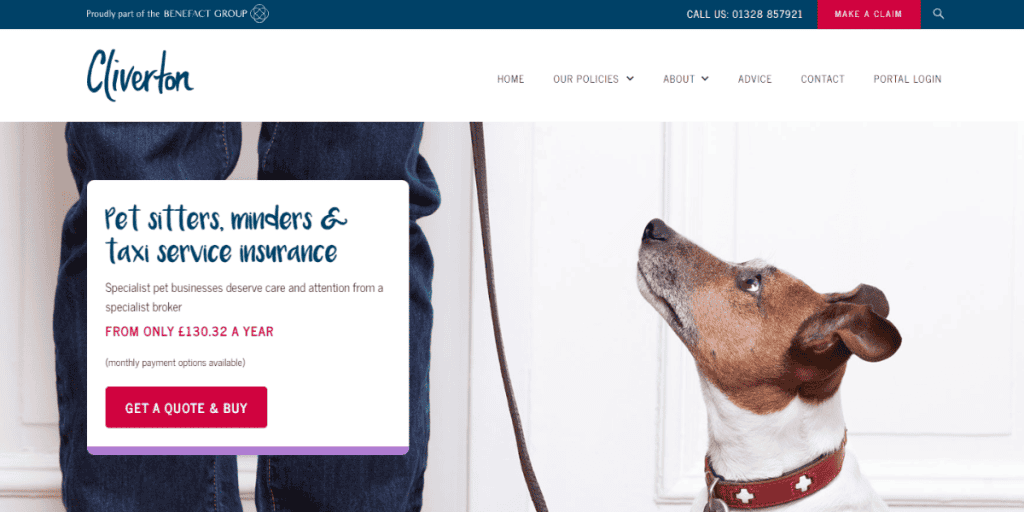The Best Pet Sitting Insurance Providers (Top 5 Picks)

If you’re like me and all the other pet sitters out there, finding the best pet sitting insurance policy is one of the main reasons you got into animal care in the first place.
Not what you’re into?
Well, ok then weirdo. But you still need to bite the bullet and get it over with.
In this post I’ll be showing you the top 5 pet sitting insurance providers out there at the moment and explaining the key features of their policies.
If you really are excited about pet sitting insurance, I’ve got some more information after, persuading you why you really need it and explaining the terms you’ll need to understand. If you really love insurance, I’ve got another post on the average costs and what factors affect the price.
Want to know more about the ins and outs of pet sitting in general? Check out this ultimate guide!
The 5 Best Pet Sitting Insurance Providers
When choosing the best pet insurance for you, it’s important to look at different coverage options, exclusions, and benefits. Below is a comparison of five top pet insurance providers, tailored specifically for pet sitters.
1. PetPlan Sanctuary
Who it’s best for: Pet sitters looking for comprehensive coverage with strong customer support and a good claims process.
- Public Liability Coverage: Up to £5 million.
- Care, Custody & Control: Up to £25,000 per pet.
- Key Features: Offers protection for third-party liability, accidents, illness, and lost keys.
- Special Benefit: 24/7 veterinary advice hotline included.
- Drawbacks: Premiums can be on the higher side compared to competitors.
2. Cliverton
Who it’s best for: Freelance pet sitters who want tailored business insurance for pet services.
- Public Liability Coverage: Up to £10 million.
- Care, Custody & Control: Standard in most policies.
- Key Features: Designed specifically for pet-related businesses with options for dog walking, pet boarding, and pet sitting.
- Special Benefit: Covers a wide range of pets including exotic animals.
- Drawbacks: May lack additional services like customer support hotlines or extra wellness benefits.
3. Simply Business
Who it’s best for: Independent pet sitters and small pet care businesses looking for customizable, affordable policies.
- Public Liability Coverage: Up to £5 million.
- Care, Custody & Control: Available as an add-on, with flexible options to meet specific needs.
- Key Features: Covers public liability, professional indemnity, and property damage. You can easily tailor coverage to include things like equipment protection and lost key insurance.
- Special Benefit: Offers a user-friendly online platform for policy management and instant quotes.
- Drawbacks: Care, custody, and control is not included by default, so coverage needs to be carefully reviewed and adjusted based on your business needs.
Simply Business offers an excellent combination of flexibility and affordability, making it a great option for pet sitters who want to build their own insurance plan.
4. Protectivity
Who it’s best for: Pet sitters seeking affordable premiums with comprehensive basic coverage.
- Public Liability Coverage: Up to £5 million.
- Care, Custody & Control: Standard with the policy, up to £25,000 per incident.
- Key Features: Provides coverage for accidents, illnesses, and public liability.
- Special Benefit: Includes coverage for dog walking and boarding in one policy.
- Drawbacks: Limited customer service hours and no 24/7 support.
5. PBI Pet Insurance
Who it’s best for: Pet sitters who want a balance between cost and coverage.
- Public Liability Coverage: £1 million to £5 million.
- Care, Custody & Control: Available as an add-on.
- Key Features: Competitive rates for small businesses and independent sitters.
- Special Benefit: Offers customizable plans with easy online management tools.
- Drawbacks: Limited cover for specialist or exotic animals unless specified.
Why You Need Pet Sitting Insurance
Even if you’re a part time pet sitter, you’re still running a business. And like any business, you need to protect yourself from potential risks. Pet sitting insurance is one of those layers of protection you shouldn’t overlook.
Legal Protection Against Liability Claims
Imagine this: You’re walking a client’s dog, and it suddenly bites another dog or person. Without insurance, you could be personally liable for medical bills and legal fees. Pet sitting insurance provides a safety net in these situations.
Most policies cover up to £1 million in public liability claims, giving you peace of mind while you work.
Coverage for Accidents or Injuries to Pets in Your Care
Accidents happen, even to the most careful pet sitters. A cat might escape and get injured, or a dog could fall ill under your watch. These situations can be stressful and costly.
Pet sitting insurance often includes care, custody, and control coverage, which can help with vet bills if a pet is injured while in your care.
Protection for Your Business Equipment and Property
As a pet sitter, you likely have equipment like leashes, carriers, or even a specialised vehicle. But what if these items are damaged or stolen during your work?
Many insurance policies offer coverage for business equipment, protecting your investments and helping you replace essential items quickly.
Peace of Mind for You and Your Clients
When clients know you’re insured, it builds trust. They feel more comfortable leaving their beloved pets in your care, knowing there’s financial protection in place if something goes wrong.
Display your insurance certificate prominently on your website or social media profiles to boost client confidence.
Professional Memberships
Many professional pet sitting organisations require members to have insurance. It’s seen as a mark of professionalism in the industry.
Having insurance can open doors to networking opportunities and additional training through these professional bodies.
The cost of insurance is often far less than the potential cost of a single incident.
For example, the average cost of dog bite claims in the UK is around £9,500. Compare that to the annual premium for pet sitting insurance, which typically ranges from £50 to £200 per year.
What Should Your Pet Sitting Insurance Cover?
When you’re shopping for pet sitting insurance, it’s easy to feel a bit overwhelmed by all the different types of coverage on offer. But don’t worry, I’m going to explain the key terms you should know when you’re doing your research.
General (Public) Liability Insurance
This should be included in any worthwhile insurance policy. General liability insurance protects you if someone gets injured or their property is damaged because of your business activities.
Most policies offer between £1 million and £5 million in general liability coverage.
For example, imagine you’re walking a dog and it knocks over an expensive vase in your client’s home. Or perhaps a cat you’re looking after scratches a visitor to your client’s house. In these cases, general liability insurance would cover the costs of replacing the vase or treating the visitor’s injury.
Professional Liability Insurance (Errors and Omissions)
Also known as indemnity insurance, this covers you if a client claims you’ve made a mistake or been negligent in your work.
This type of insurance can cover legal fees and compensation if you’re sued.
Let’s say you forget to give a pet its medication, leading to a health issue. Or perhaps you misunderstand the owner’s instructions and feed a pet the wrong food, causing an allergic reaction. Professional liability insurance would protect you in these situations.
Care, Custody, and Control Coverage
This is specific to businesses that look after other people’s property – or in your case, pets. It covers you if an animal in your care is injured, becomes ill, or goes missing.
Look for policies that offer at least £25,000 in care, custody, and control coverage.
For instance, if a dog you’re walking slips its lead and runs away, this coverage would help pay for search efforts. Or if a cat in your care needs emergency vet treatment, this would cover the bills.
Lost Key Coverage
As a pet sitter, you’re often trusted with keys to your clients’ homes. Lost key coverage protects you if these keys go missing.
This coverage typically pays for the cost of replacing locks and keys.
Imagine you’re out walking a dog and you lose the key to your client’s house. This coverage would pay for a locksmith to come and change the locks, saving you from a potentially expensive and embarrassing situation.
Property Damage Protection
This covers damage to your own property that occurs as a result of your pet sitting activities.
Check if this coverage extends to your vehicle if you use it for work.
For example, if a dog you’re looking after chews up your sofa or scratches your car door, property damage protection would cover the cost of repairs.
Bonding Insurance
While not strictly a type of insurance, many pet sitters choose to be bonded. This protects your clients against theft or dishonesty.
Being bonded can give clients extra peace of mind and may help you win more business.
If an employee of your pet sitting business steals from a client’s home, bonding insurance would cover the loss. It’s an extra layer of protection that shows clients you take their trust seriously.
Conclusion: Finding the Best Pet Sitting Insurance
Like setting up contracts, or pet-proofing your home, sorting out pet sitting insurance isn’t the sexiest item on your to-do list, but it’s important that you’re covered.
Insurance gives you peace of mind and shows your clients that you take your responsibilities seriously.
If you’re unsure about something in a policy, don’t be afraid to ask questions and seek clarification. Most insurance providers have those chat-thingys on their websites so you can get a quick answer.
Don’t overthink it. Have a look at the five I’ve suggested, pick one that suits you, then go back to pspspsps-ing the cat.











